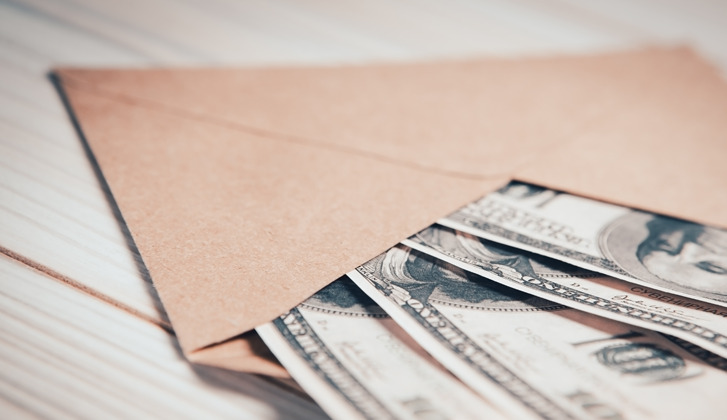NOTICE: Internet Explorer was retired by Microsoft on June 15th, 2022 and is no longer supported. This could change how you access Online Banking.
The Cash Envelope System: A Hands-on Approach to Budgeting

Welcome to WesBanco Wellness; a Series for Your Financial Health. Here we will tackle budgeting, debts, safe web practices and more to help get you into the best financial shape of your life.
Are you having trouble budgeting? Do you find it hard to keep track of what you’re spending? With the cash envelope system, you put actual cash into pre-labeled envelopes to pay for gas, groceries, clothing, and other monthly expenses. This article will walk you through the system, give you handy tips, and discuss the pros and cons. The cash envelope system encourages you to keep your debit card in your wallet and opt for using cash.
The Envelope System: How it Works
Using the cash envelope budgeting method, you can physically portion out your monthly income for different categories of spending. Take a few envelopes and write the expense category on each one – things like groceries, gas, entertainment, etc. Then, put the money you intend to spend on those expenses into the envelopes. You won’t need to create envelopes for fixed expenses, like your rent or mortgage, car payments, or loan payments. Because those recurring payments should stay the same, you can use automatic bill pay to manage those expenses.
Variable expenses often cause people to go over their monthly budgets. The cash envelope system is designed to keep you on track by giving you just a certain amount to spend. Here’s how to get the system working for you:
Step 1: Sort Expenses Into Categories
First, think about what kind of variable expenses you have and sort them into categories. Here are some examples:
- Groceries
- Gas
- Household supplies
- Going out
- Clothing
- Pet care
- Medicine/vitamins
- Gifts
- Car maintenance
- Personal care/toiletries
- Hair care
You can keep the categories general, such as “going out,” or you can get more specific and use separate envelopes for “movies,” “restaurants,” or “drinks.” How you sort the categories is up to you. It’s a good idea to have one envelope for miscellaneous expenses. You can use that money to cover unexpected expenses without having to dip into your emergency fund.
Step 2: Create a Budget
Once you have your envelopes sorted, you’ll want to draw up a budget so you can figure out how much you spend each month. To do that, take a look at your bank and credit card and bank statements from the past few months. That can give you an idea of what you’ve been spending and help you determine how to budget your money. Look for problem areas: if you tend to overspend on entertainment or impulse items or gifts, think about limiting your spending to a certain amount each month. If eating at restaurants is blowing your budget, figure out what you can comfortably afford to spend and stick to it.
When you’re creating your budget, you can use the 60-20-20 rule, which can help you adjust your spending to make sure you’re covering living expenses and putting enough toward savings.
- 60% for Living Expenses
These are costs such as rent, utilities, groceries, and your phone bill. While you wouldn’t use envelopes for many of these fixed expenses, you would for groceries, which can sometimes break your budget if you grab too many impulse items. - 20% for Savings
Experts recommend putting 20% of your income away. You can divide this between your emergency fund, longer-term savings, and retirement, and set up automatic transfers to make saving easier. Keep in mind that your emergency fund would be separate from your miscellaneous expenses. - 20% for Fun
Depending on your lifestyle, fun could be things such as shopping, eating at restaurants, or traveling. Using the envelopes, you can decide how to divide up this portion of your income. Allocating 20% of your budget for things you want but don’t necessarily need can help you control spending.
Let’s say you take home $4,000 a month. Here’s what your budget might look like:
- $2,400 for living expenses
- $800 for savings
- $800 for fun
Step 3: Label Each Envelope and Fill It
Once you’ve figured out your budget, take your stack of envelopes and label each one with a spending category. You can think about color-coding your envelopes so you can easily tell them apart. As we mentioned above, you can get as specific as you want when labeling, especially if it will help you budget more appropriately.
You’ll want to fill your envelopes next. If you budgeted $600 a month for groceries and get paid twice a month, take out $300 from your first paycheck of the month and put it in your “grocery” envelope. Then, on your second payday of the month, put $300 in that envelope. That’s your grocery budget for the month.
When you go to the grocery store, make sure you have enough money to cover what you need for that trip. If you bring $150 and your bill is $170, you’ll need to put some items back. This is the toughest part of sticking to a budget. But it’s better than overspending and wrecking your monthly plan.
Remember: Spend money from the grocery envelope ONLY at the grocery store. Don’t use it for any other expenses. The same goes for your other envelopes.
The envelope system works best for things like grocery shopping, eating out, and getting a manicure – where you’re physically making a purchase. If you buy things online, you can still use the envelope system, but you’ll need to make some adjustments. Write the amount you’ve budgeted on the outside of the envelope and don’t spend more online than that amount. You’ll also need to keep track of how much you’ve spent and record it on the back of the envelope the same way you’d balance a checkbook.
Step 4: Spend Only What Is in the Envelope
Once an envelope is empty, you’ll need to wait till next month to fill it up. The purpose of using cash envelopes is to control your spending and help you stick to your budget.
- Don’t Spend What You Don’t Have
If you’ve spent all your grocery money, raid the fridge for leftovers or go through your pantry to make your meals. If you’re gas envelope is running low, think about limiting trips, taking public transportation, or carpooling. - Don’t Borrow From Other Envelopes
Let’s say you run out of personal care money. It can be tempting to borrow from another envelope. Resist the urge!
Cash Envelope Advantages
There are several advantages of the cash envelope system:
- It Prevents You From Building Up Debt
You can’t wrack up credit card charges if you use cash. You’ll also benefit from no overdraft fees. - It Keeps You From Overspending
By physically dividing up your cash, you can see much you have to spend, which can help you avoid impulse purchases. - It Helps You Stay Within Your Budget
All those little charges on your debit card can add up, dinging your budget. By paying cash, you’re more conscious of what you’re spending and it’s easier to not go over your budget. - It Gives you an Emotional Connection to Your Money
Because cash is tangible – you can see it and feel it – you become aware of what you’re actually spending and will likely spend less than you would with a credit card.
Cash Envelope Disadvantages
But there are also some drawbacks:
- Inconvenience
Going to the ATM regularly to withdraw money can be inconvenient and time-consuming. - Risk of Theft or Loss
Carrying around large amounts of cash is riskier than using a debit card. If your debit card is lost or stolen, you’re protected. If your cash is lost or stolen, it’s gone. - No Rewards
If you use a credit card, you can earn rewards and pay off the balance each month; not so with cash. - Cash-Free
Some stores and restaurants are going cash-free to help speed up the payment process, making it challenging to pay with cash. - Extra Effort
While this system can help you stay within your budget, it takes substantial time and effort.
Money Left at the End of the Month
Sticking to a budget takes discipline, and it’s hard not to overspend. If you make it through the month with cash left over, you’re ahead of the game! Celebrate with a mocha latte or dinner at your favorite restaurant. Rewarding yourself is important because it helps you stay motivated to stick with the program.
If you want the best bang for your buck, you could take that extra cash and put it toward next month’s expenses, or you can put it in savings or use it to pay down other debts.
The envelope system helps you take control of your finances in a truly hands-on way. It’s a valuable tool, especially for impulse spenders and those new to budgeting and can help you determine how much to spend and save each month.
For additional help with budgeting or managing your finances, reach out to your local banking center and schedule an appointment to speak with a Personal Banker.
Content is for informational purposes only and is not intended to provide legal or financial advice. The views and opinions expressed do not necessarily represent the views and opinions of WesBanco.
While we hope you find this content useful, it is only intended to serve as a starting point. Your next step is to speak with a qualified, licensed professional who can provide advice tailored to your individual circumstances. Nothing in this article, nor in any associated resources, should be construed as financial or legal advice. Furthermore, while we have made good faith efforts to ensure that the information presented was correct as of the date the content was prepared, we are unable to guarantee that it remains accurate today.
Neither Strategy Academy nor its sponsoring partners make any warranties or representations as to the accuracy, applicability, completeness, or suitability for any particular purpose of the information contained herein. Strategy Academy and its sponsoring partners expressly disclaim any liability arising from the use or misuse of these materials and, by visiting this site, you agree to release Strategy Academy and its sponsoring partners from any such liability. Do not rely upon the information provided in this content when making decisions regarding financial or legal matters without first consulting with a qualified, licensed professional.
Looking for Savings?
The perfect companion to your WesBanco checking account. All of our accounts are available with a Companion Savings account with no minimum balance requirement or monthly maintenance fee when monthly statements are combined and accounts have identical ownership.
Companion Savings
Free Mobile Deposits



